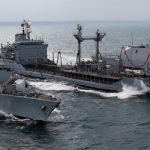Avascent First Person: David “Chip” Berke on the future of 5th Generation Fighter Jets
About David “Chip” Berke
 LtCol David “Chip” Berke, USMC (ret) is one of the most experienced fighter pilots in the world today, with extensive operational, leadership, and training experience flying 5th Generation Fighter Jets
LtCol David “Chip” Berke, USMC (ret) is one of the most experienced fighter pilots in the world today, with extensive operational, leadership, and training experience flying 5th Generation Fighter Jets
He is the only pilot ever to fly the F/A-18 Hornet, F-16 Fighting Falcon, F-22 Raptor, and F-35B Lightning II operationally.
He led the first tests and established tactics to integrate Fourth and Fifth Generation aircraft as the Commander of the Raptor Division. He also served as the Commanding Officer of the Marine Corps’ first F-35 squadron, and was the first operational pilot qualified in the F-35B.
His training experience includes developing and implementing the first syllabus for US and International Lightning II pilots and serving as the TOPGUN Training Officer, the senior instructor at the US Navy’s Fighter Weapons School.
He also deployed to Ramadi in 2006 as a Forward Air Controller during intense urban and rural ground combat.
He finished his career serving as a Branch Chief and playing a leading role as a member of the Joint Staff Innovation Group assisting the Vice Chairman of the Joint Chiefs.
David works with Avascent helping US and allied efforts on the operational, training, and defense industrial challenges associated with transitioning to Fifth Generation fighters.
You’ve flown the F-35, F-22, F-16 and F-18. What’s your top take-away about the future of the fighter and how the US will deploy and invest in them during the next decade?
The biggest takeaway for me is how different the airplanes are. You can put the F-35 and F-22 in one category and the F-16 and F-18 in another category. I learned very quickly to stop thinking of them as being similar at all.
Even the F-35 is different enough from the F-22 that it could probably be in its own category. The most important thing we can do is stop looking at the F-35 – or any 5th Generation fighter jets – like its predecessor.
We understand the continuum, the chronology, that it all aligns linearly but I almost wish we didn’t talk about that aircraft as a fighter. I’ve learned to view the airplane and how it contributes to the world around it so much differently than an F-18.
I don’t even like talking about how they are similar because it dilutes the conversation about what should we be thinking about the future, where do we invest, and how do we consider what the aircraft do for us. The more decoupled the F-35 is from the previous 100 years of aviation, the more likely we are to take advantage of what it can do.
From an allied perspective, what are the operational implications of adding more and more 5th Generation fighter jets to squadrons in Asia and Europe?
The biggest operational implication is that you have to find a way to be connected from a communications standpoint. I don’t mean pure communications like talking on the radio, I mean speaking a common language.
We have found throughout history that the way we fight wars is that we like joint, combined fighting – we like to work together. But at the operational level, and below that at the tactical implementation level, it’s really hard.
If you told me, “Hey Dave, you’re flying F-18s today and I want you to partner up with these F-16s” – people see them as similar but don’t realize there are many different friction points that we have to work through because we just do things differently with each aircraft.
It takes time to figure out how to operate together because if we get it wrong we create a huge amount of risk. If we don’t figure out how legacy aircraft and 5th Generation fighter jets will work together, our chances of having mission failures, or getting hurt or killed, are much higher than just fighting an enemy.
You have to spend this inordinate amount of time to just break down those communication barriers, whether they’re little barriers or entire ways of doing business differently.
So, if I have a bunch of countries that are literally speaking different languages and flying different machines, I’m going to spend all my time working out how to make those elements work together.
That massive barrier is removed when the airplanes are the same because people are seeing the world through the same set of eyes. Now, you will have friction points you must manage, but people underestimate how hard it is to just integrate different types of aircraft together.
If you’re a country and you don’t have that synergy, the risk of being excluded operationally is very, very high and more so as the future gets closer to us.
What are people missing when they discuss the next generation of fighter aviation, particularly industry’s role in what will come after F-35 and F-22?
The “what comes after” question is a crucial for right now. It’s one thing to recognize how different 5th generation fighter jets are compared to their predecessors. But as we’re looking to build the next generation of fighters, how do we create capabilities that are going to do the things we think an airplane needs to do when we’re talking 2040 and beyond?
We’re operating on a very shaky foundation. I don’t think it’s understood industry-wide even what an F-35 and F-22’s capabilities are. If you couple that with a really muddy view of what the future will hold, I think we need to develop new approaches to analyze and build something that’s going to be effective in the latter half of the century. It’s a conversation we need to be having now.
How then should we move forward? I think the simplest term and the most effective commodity in warfare has always been and always will be information. There’s a lot of buzzwords out there like “information dominance,” but it’s really just the ability to understand what’s going on around you, prevent threats from attacking you, and impose your will on other people.
That’s really warfare in a nutshell: being survivable and lethal. We are much more connected now to the different layers of combat, whether it’s space, air, sea or sub-surface and land; the more connected those domains are, the more effective we are.
I don’t want it to be just about warfare, but it’s important to think in those realms – so you need to have as seamless as possible a connection. And there has to be a facilitator for the thing above it and the thing below it to interact – that’s the future of warfare.
We don’t really understand what that means because we haven’t really implementation it. Although we’re starting down that road, we have a lot of work to do.
Are we already in the era of the non-kinetic cyber or EW dogfight?
No doubt. And I love that you connected the term “dogfight” to this non-kinetic interaction to the threats around us.
Think of it just in terms of cyber warfare. If you sat down next to those cyber operators – literally sat down next to them at a computer – they could tell you, “I am fighting an adversary in real time.” I don’t think people understand that that is a literal dogfight.
Now, it’s not a physical aerial engagement in that you don’t replicate the G forces, heavy breathing, looking over your shoulder, pulling on an airplane to try to get behind your aggressor or adversary. But the exact same maneuvers are happening, digitally speaking.
That really gets to the heart of having to view the airplane differently: stop thinking about how does it physically turn, stop thinking about Bernoulli’s [Principle], stop thinking about lift, stop thinking about drag coefficients and wing loading. I don’t mean to say those are meaningless, they are important, but they should not define the qualities that are valuable in an airplane.
Think about how much non-kinetic warfare happens every day. That is simply going to grow. Part of the reason it’s going to grow is that the rest of the world can’t build equipment and machines to fight us — so they’re not going to.
Most of our potential threats in the world are not going to be able to build a better plane, or a better tank or a better gun. They are going to build better other capabilities that will allow them to fight us in a contest that will boil down to person-against-person conflict.
It’s hard for us to decouple our viewpoint of dogfighting because our vision of it is literally visual and recalling what we’ve been doing flying airplanes since World War One: two airplanes turning through the sky in relation to each other.
Ironically, we haven’t done that in decades. We haven’t really turned visually with another airplane in my professional lifetime and we probably won’t. And if we did, it would represent fraction of a percentage of the time we spend fighting wars. So it shouldn’t be the focus.
There’s a lot of operational change and technological disruption ahead then in the fighter community – as well as the broader defense realm. Talk about the mindset in the cockpit and outside of it needed to navigate that.
The aircraft that we’re building now actually have the ability to be massive disruptors. The problem is that we take advantage of a small percentage of their capability.
I attribute that to legacy thinking. An example is the inability to view the F-35 as anything other than an airplane that works just like the airplanes that came before it.
So, as a result, we overlook the attributes baked into the platform to do so many other things, like communicate with sensors and platforms in different realms to create a much broader footprint where you can engage kinetically and non-kinetically. When we think in those legacy terms we don’t take advantage of the truly disruptive capabilities.
More creative and innovative approaches are needed. That means inviting nontraditional players to the table and asking these non-military, non-aviation folks, “What would you do with this?”
Lay out all the things we think a machine can do and then ask them what they think it can do. We’re not really good at bringing outsiders in and getting their ideas about what they would do with technology.
The inability to bring in fresh perspectives on potentially disruptive technologies is what prevents them from being disruptive. The worst part about it is that it will prevent us from effectively developing game-changing equipment down the road, whether it’s the replacement to the F-35 or the replacement to anything else.
Innovative thinking really means I’m not going to tell you what something does. Instead, make room for fresh perspectives while asking the end user, “What can you do with this?”
An essential element in the relationship with technology is trust, so how do you know when you as a pilot or commander get to the point when you can really trust your aircraft? And what are the implications then as we go deeper into the era of highly advanced systems, including unmanned military aircraft?
I think the trust piece is very difficult. It’s hard to overstate how much operators don’t trust their equipment to do things that they themselves have been trained to do.
A small anecdote is that in pilot training you learn all these battle management skills, and when you get in an airplane like an F-35, it’s so different.
You realize that all those things you trained for, the airplane is better at doing than you are. It’s like the idea of using machine learning to play chess – it’s just better than you. Rationally, you should let a computer play chess for you – but we don’t like doing that.
The way you develop trust with these highly technologically-centered pieces of equipment is you put yourself in these really stressful environments where you realize you can’t keep up with what’s going on. Then you see how the airplane interacts with the environment around you and delivers information that’s critical.
As an aviator, it’s even like this in legacy aircraft. You start to figure out that the airplane and its systems understood what was happening. Your airplane saw this and my airplane saw this yet we didn’t talk about it, but the aircraft effectively did.
Once you start to figure out that the airplane is better than you are, you start to time-share away from tasks you realize it should be doing while you handle other things. It’s really about paying attention to what the aircraft is telling you that is most important in building trust.
The airplane is only going to get more capable in its ability to learn from its pilot’s experiences, so training needs to stay a step ahead of that to optimize the human-machine relationship.
Any capability or platform exists in a complex system, not on its own. What are some of your lessons learned takeaway from coming in as an outsider into high performance military organizations like TOPGUN, where you were the senior instructor and training officer?
Throughout my career, I’ve found myself working in nontraditional places. I’ve spent at ton of time with the Navy on carriers and at TOPGUN, a ton of time with the Air Force, and a ton of time with the Army during my time as a Forward Air Controller (FAC).
I actually spent very little time as a Marine doing traditional Marine missions. I learned that it’s a two-step process: you very quickly want to demonstrate the ability to assimilate, to culturally align, with how their organizations do business.
If you want to create cultural change or make some improvements to how you think they should be doing business, the first thing you need to do is be accepted into that culture or that organization.
My objective in all these new places I ended up as a Marine was to quickly say, “I want to know how you do business and I’m going to business exactly like you.” The quicker you develop that rapport, the more likely they are going to listen to you. If you walk in on Day One and say, “This is how I do it,” you’re going to be rejected.
If you want cultural change or if you want to be an influencer in larger systems, try to find a way to accommodate to the way they do things initially. Then over time if you demonstrate you’re really good at how they do business, you’re going to be a much more credible voice.
We all have ideas about how to do things differently and the worst thing you can do is the frontal assault because people almost always reject it. But if you do an end-run and say, “Hey I’m just going do it your way for a while so I learn how you do it, I’m going to find things that I thought were wrong that were right, and I’m going to find things that you think are right that are wrong,” then you build a rapport to be able to have that conversation about meaningful change.
There’s a ground level perspective that leaders often lack. How did your tour as a Marine Corps Forward Air Controller in Iraq change how you thought about potential and limitations of 5th Generation fighter jets when you went on to the F-22 and F-35?
Ironically, the FAC tour is what made me think three dimensionally as an aviator. I always thought I had a three-dimensional viewpoint, because I was up high and seeing the world from the top down.
What I didn’t realize was that if you don’t understand what is really happening at the ground level you still view it somewhat two dimensionally – it’s just that the dimensions are above the ground.
Now, aviators do understand the flat space very well, and they understand ground combat to some degree. But what humbled me is how different the chaos is on the ground. It taught me to just try to look at the world through a new perspective.
I learned that it wasn’t helpful for me to say, “This is what I see from up here in the sky.” It was better to say, “Hey, I’ve been down there and now that I’m up here I want you to get a different perspective… look over here, look over there.”
If you understand what is happening on the ground, you’re more effective in telling them what you see from the sky. You’re a translator of those different perspectives.
That’s exactly what 5th Generation fighter jets are: It’s telling the pilot in a legacy aircraft, I understand how you view the environment because I’ve lived there, while I am in this other space where my sensors, my footprint, and the way I see the world are totally different than yours.
But I can’t just say these are all the things that I see, because there is no frame of reference for that. But what you can do is actually translate what you see and fuse it into a single explanation or picture. Now you can only do it incrementally.
The risk is if you just say, here’s my information, take it, the other pilot is going to have no use for it because they won’t have any frame of reference. And if you just explain in the same manner in which they currently see the world, then it doesn’t add value.
Your job as a Fifth Gen pilot comes down to bridging those perspectives. It’s hard to overstate how difficult that is, and how challenging the transition to 5th gen flying can be. We are seeing virtually everyone struggle with it.





